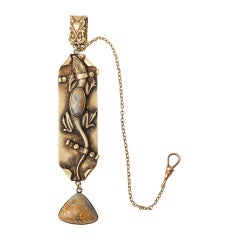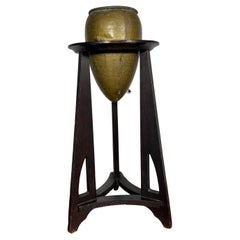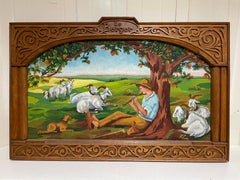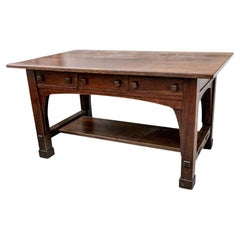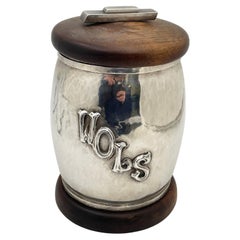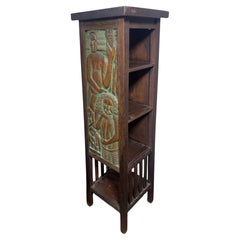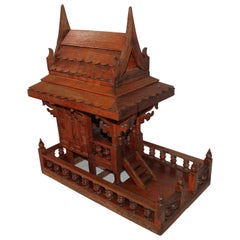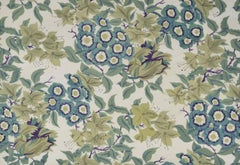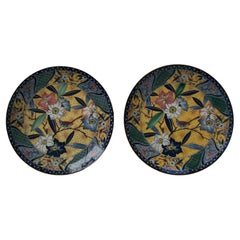Arts And Crafts Style Art
Vintage 1910s American Arts and Crafts Brooches
Gilt Metal
Vintage 1910s American Art Nouveau Planters, Cachepots and Jardinières
Brass
Mid-20th Century Art Nouveau Animal Paintings
Oil
Early 20th Century American Arts and Crafts Desks and Writing Tables
Oak
Early 20th Century American Art Deco Sterling Silver
Silver, Sterling Silver
Vintage 1920s Unknown Arts and Crafts Sculptures and Carvings
Oak
Early 20th Century American Adirondack More Folk Art
Oak
1920s Drawings and Watercolor Paintings
Gouache
Mid-20th Century Japanese Anglo-Japanese Ceramics
Ceramic
21st Century and Contemporary Indian Arts and Crafts Western European Rugs
Wool
Early 20th Century Norwegian Folk Art Antiquities
Pine, Hardwood, Beech
Early 20th Century Canadian Arts and Crafts Desks and Writing Tables
Oak
1920s Other Art Style More Art
Metal
Late 20th Century Abstract Geometric Abstract Paintings
Silver, Gold Leaf
Late 20th Century French Arts and Crafts Chandeliers and Pendants
Bronze
Mid-20th Century American Arts and Crafts Pottery
Pottery
Vintage 1910s English Arts and Crafts Tableware
Silver, Sterling Silver
Early 20th Century Austrian Arts and Crafts Chandeliers and Pendants
Bronze
Early 20th Century American Arts and Crafts Paintings
Wood
Mid-20th Century Drawings and Watercolor Paintings
Watercolor
1980s Contemporary Still-life Prints
Lithograph
Early 20th Century English Arts and Crafts Quilts and Blankets
Fabric, Textile
Mid-20th Century American Mid-Century Modern Animal Sculptures
Brass
1920s Post-Impressionist Figurative Paintings
Oil, Canvas
Vintage 1940s Belgian Arts and Crafts Chandeliers and Pendants
Copper
Early 20th Century Scottish Arts and Crafts Chandeliers and Pendants
Bronze
Vintage 1920s English Arts and Crafts Serving Bowls
Silver, Sterling Silver
Vintage 1970s American Arts and Crafts Screens and Room Dividers
Hardwood, Oak
Mid-20th Century Drawings and Watercolor Paintings
Watercolor
Early 20th Century Edo Furniture
Wood
21st Century and Contemporary Persian Arts and Crafts Persian Rugs
Wool
Early 20th Century Northern Irish Arts and Crafts Western European Rugs
Wool
Vintage 1910s English Arts and Crafts Decorative Bowls
Pottery
Antique Early 1900s Dutch Arts and Crafts Floor Mirrors and Full-Length ...
Mirror, Padouk
Early 20th Century American Arts and Crafts Decorative Bowls
Pottery
Early 2000s Pakistani Arts and Crafts Central Asian Rugs
Wool
Antique Late 19th Century English Arts and Crafts Andirons
Metal, Brass, Iron
20th Century American Lanterns
Copper
Late 20th Century Persian Arts and Crafts Persian Rugs
Wool
Antique 1890s English Art Nouveau Desks and Writing Tables
Wood
Mid-20th Century Turkish Arts and Crafts Turkish Rugs
Wool
Early 20th Century Persian Arts and Crafts Persian Rugs
Wool
Antique Early 1900s English Arts and Crafts Shelves and Wall Cabinets
Oak
Antique Late 19th Century Persian Arts and Crafts Persian Rugs
Wool
Early 20th Century European Arts and Crafts Chandeliers and Pendants
Alabaster, Brass, Bronze, Wire
Early 20th Century Persian Arts and Crafts Persian Rugs
Wool
1990s American Impressionist Still-life Paintings
Canvas, Oil
Antique Early 1900s British Arts and Crafts Platters and Serveware
Sterling Silver
1970s Abstract Paintings
Masonite, Oil
Late 20th Century Turkish Arts and Crafts Turkish Rugs
Wool
21st Century and Contemporary Indian Oushak Turkish Rugs
Wool
Mid-20th Century Persian Arts and Crafts Persian Rugs
Wool
Early 1900s Victorian Figurative Drawings and Watercolors
Ink, Watercolor, Gouache, Board
Vintage 1930s American Arts and Crafts Patio and Garden Furniture
Wrought Iron
Early 20th Century Spanish Arts and Crafts Western European Rugs
Wool
Mid-20th Century Romanian Arts and Crafts Western European Rugs
Wool
Vintage 1950s Great Britain (UK) Arts and Crafts Sterling Silver
Silver, Sterling Silver
20th Century Spanish Arts and Crafts Cabinets
Wood
- 1
- ...
- 1stDibs ExpertAugust 15, 2019
The Arts and Crafts Movement was an era of design that originated in England during the last quarter of the 19th century. The movement celebrated traditional craftsmanship by way of simple forms and the use of romantic, medieval or folk styles of decoration.
- 1stDibs ExpertApril 26, 2024The style of Keith Haring's art is Pop art. This style emerged in the 1950s, when artists first began drawing on popular culture when producing original paintings, prints and sculptures. Haring found his inspiration in cartoons, adapting the style for his paintings, prints and murals that addressed the universal themes of death, love and sex, as well as contemporary issues, like the crack cocaine and AIDS epidemics. Find a range of Keith Haring art on 1stDibs.
- What is the Inuit art style?1 Answer1stDibs ExpertMarch 22, 2022The Intuit art style describes the artwork produced by indigenous people from the Arctic region. Inuit art is largely handmade and includes sculptures, masks, handicrafts and prints. Shop a collection of Inuit art from top artists and sellers on 1stDibs.
- 1stDibs ExpertMarch 13, 2024Kandinsky's style of art varied over the course of his life. He embraced styles such as Surrealism and Fauvism. In addition, he was a leading figure in bringing together Der Blaue Reiter, a group of avant-garde artists in Munich that included Paul Klee and Franz Marc. Kandinsky and other members explored spiritual concepts through their art as a response to the materialism of the time. On 1stDibs, explore an assortment of Wassily Kandinsky art.
- What was Raphael's style of art?1 Answer1stDibs ExpertMay 30, 2024Raphael's style of art is associated with a period known as the Italian Renaissance, sometimes referred to as the High Renaissance. During this era, paintings were characterized by an extraordinary depiction of light and darkness, scientifically accurate depictions of the human body, and the use of rich colors. Many of Raphael's works, such as The Marriage of the Virgin, The School of Athens and The Transfiguration, are admired by art lovers all over the world today. Find a large collection of Renaissance art on 1stDibs.
- What style of art is Fornasetti?1 Answer1stDibs ExpertFebruary 27, 2024The style of art by Fornasetti varied. His use of whimsical motifs has often led his artwork to be associated with Surrealism, while his use of repetitive imagery, like in his many prints featuring opera singer Lina Cavalieri, skewed toward Pop art. As a designer, his works reflected mid-century modern sensibilities with a playful twist. Explore a collection of Piero Fornasetti art and decorative objects on 1stDibs.
- 1stDibs ExpertNovember 4, 2024To identify Arts and Crafts furniture, first see if you can locate a maker's mark on your piece. By researching any marks using trusted online resources, you can determine who produced your piece and find out if the maker was linked with the Arts and Crafts movement. Some notable makers associated with the style include William Morris and Philip Webb. If you can't find a maker's mark, examine the details of your piece. The Arts and Crafts movement began as a reaction to mass production, highlighting craftsmanship, raw materials and simple design. Due to its handcrafted origins, Arts and Crafts furniture often displays tool marks and slight variations in carvings and details. Pieces so regular that they seem machine-made are less likely to be Arts and Crafts furniture. Other common characteristics of Arts and Crafts pieces include inlaid and carved details and natural wood materials with visible grains. Chairs often feature reclining or angled backs and armrests. If you'd like assistance determining whether a particular piece is Arts and Crafts, consider consulting a certified appraiser or experienced antique dealer. On 1stDibs, explore a range of Arts and Crafts furniture.
- 1stDibs ExpertAugust 15, 2024To identify Arts and Crafts furniture, look for characteristics that are hallmarks of the style. The Arts and Crafts movement began as a reaction to mass production, highlighting craftsmanship, raw materials and simple design. Makers working in this style placed an emphasis on natural motifs and adorned their pieces with simple flourishes like mosaics and carvings. This work is characterized by plain construction that showcases the hand of the artisan. Arts and Crafts furniture was often built from sturdy woods like oak and mahogany while featuring details such as inlaid metal, tooled leather and ceramic tiles. The style in the United States was led by Gustav Stickley, whose clean-lined chairs and benches showcased the grain of the wood, and furniture maker Charles Rohlfs, who was informed by international influences like East Asian and French Art Nouveau design. If you need help identifying the style of your furniture, a certified appraiser or knowledgeable antique dealer can be of assistance. Find a diverse assortment of Arts and Crafts furniture on 1stDibs.
- What is Ed Ruscha's art style?1 Answer1stDibs ExpertFebruary 27, 2024Ed Ruscha's art style is Pop art. He is especially well known for elevating words and signage into works of art. Ruscha began his famous series of word paintings in the 1960s, depicting various views of the Hollywood sign and the logos of studios like 20th Century Fox, but also roadside views like the Standard Oil stations dotting L.A.'s freeways. Over time, these became more abstract, with ambiguous, free-floating phrases pinned to natural vistas, scenes of highways and monochrome backgrounds. Shop a variety of Ed Ruscha art on 1stDibs.
- 1stDibs ExpertApril 5, 2022Edgar Degas dabbles in realism, expressionism and modern art, though he himself preferred the term realist. He was an artist known for his painting, drawing and sculpting work, the most notable being his paintings of ballerinas and dancers. Shop a selection of Edgar Degas pieces from some of the world’s top art dealers on 1stDibs.
- 1stDibs ExpertApril 5, 2022Lucian Freud specialized in figurative art and was best known for his portraits and nudes. Sometimes called a realist, his work focused on creating the human form in a realistic yet intense manner. Find a selection of Lucian Freud art from some of the world’s top dealers on 1stDibs.
- 1stDibs ExpertApril 5, 2022Stuart Davis's art style is largely Cubist. He used the hard-edge painting technique to create dramatic differences in color. Many of his works draw inspiration from jazz and swing music, and historians credit him with influencing the Pop artists that emerged later in the 20th century. On 1stDibs, shop a collection of Stuart Davis art.
- 1stDibs ExpertFebruary 7, 2024Henri Matisse's art style is associated with several movements, including Postimpressionism and Fauvism. He was also the leading proponent of Fauvism, a movement with a name derived from the French word for "wild beast." Marked by vibrant hues, Fauvist paintings like Matisse's famous 1906 composition Le Bonheur de Vivre use wild, active brushstrokes and a palette unconstrained by nature, resulting in women with purple skin and trees with orange leaves. Often, these compositions unite pure color with the white of the exposed canvas to create a sense of transparency and light. Shop a variety of Henri Matisse art on 1stDibs.
- 1stDibs ExpertApril 5, 2022Wayne Thiebaud is often associated with the pop art movement because he focused on common objects. His particular style predates the pop art movement, which accounts for the sometimes classification and the influences of modern art in his work as well. On 1stDibs, find a variety of original artwork from top artists.
- 1stDibs ExpertMarch 22, 2022George Rodrigue’s art style is largely classified as Pop art. He often used hard-edge techniques to create dramatic transitions between colors. Much of his work focuses on the landscapes and residents of Louisiana. On 1stDibs, shop a range of George Rodrigue art.
- 1stDibs ExpertApril 5, 2022Derrick Adams is a multidisciplinary American artist whose work probes and deconstructs the African American experience, specifically as it relates to the long history of art as well as consumerism. His mediums include painting, collage, sculpture, performance, drawing and video. Browse a wide selection of authentic Derrick Adams art pieces on 1stDibs.
- 1stDibs ExpertApril 5, 2022Many art styles originated in Japan and grew in popularity over the years. Some of the most popular styles include shodo (calligraphy), ikebana, kanou and yamato-e. You’ll find a wide variety of authentic Japanese art from some of the world’s top dealers on 1stDibs.
- 1stDibs ExpertAugust 15, 2019
Art Deco style furniture appeared right before the start of World War I and is defined by sharp lines, vibrant colors and bold patterns. Heavily influenced by geometry, Art Deco furniture was born out of the Cubism movement.
- 1stDibs ExpertApril 22, 2024Piet Mondrian's style of art varied over the course of his career. His early works display the characteristics of Post-Impressionism, but his paintings grew more abstract over time. Art historians classify many of his later works as Expressionism or Cubism. Find a selection of Piet Mondrian art from some of the world's top galleries and dealers on 1stDibs.
- What style of art is Ben Shahn?1 Answer1stDibs ExpertFebruary 7, 2024The style of art of Ben Shahn is social realism. Artists working in this movement sought to highlight social issues by depicting scenes that showed the struggles of modern-day life. For example, Shahn produced four paintings and more than 100 drawings inspired by a 1947 mining accident that killed 111 people in Centralia, Illinois. Arguably the most famous of these works is Miner's Wives, which shows the widows of the miners in mourning. On 1stDibs, shop a variety of Ben Shahn art.
